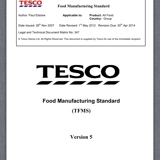Information
-
Document No.
-
Audit Title
-
Client / Site
-
Conducted on
-
Prepared by
-
Location
-
Personnel
5.1 - SITE LOCATION (BASE)
-
The site must comply with local regulations regarding approval or registration of premises and processes
5.2 - SITE BOUNDARIES (BASE)
-
Site boundaries must be clearly defined and have adequate perimeter fencing
-
A site plan must be available
-
WGLL - entrance to site via a manned security barrier / check point
-
WGLL - where no fencing exists (eg. The site is on a business park, isolated location in countryside etc) the site is secure to prevent unauthorised public access, domestic animals and unlawful entry
5.2.1 - SITE BOUNDARIES (ASPIRATIONAL)
-
The site is surrounded by secure fencing and monitored by CCTV
5.3 - EXTERNAL MAINTENANCE (BASE)
-
External areas must be kept tidy and free from unnecessary items that could provide potential pest harbourage
5.3.1 - EXTERNAL DRAINAGE (BASE)
-
The yard area must have adequate drainage to prevent pooling water around storage and process areas (eg. Milk reception) and allow cleaning
5.3.2 - EXTERNAL DRAINAGE (ASPIRATIONAL)
-
External drains are visually identified as factory effluent, surface water or sewage and show direction of flow
-
WGLL - painted colour coded arrows on the drain covers, showing direction of flow and waste type.
5.4 - GRASS / PLANTED AREAS (BASE)
-
When present, vegetation must be kept trimmed and clear from production and storage buildings (approx 1 meter clearance, to prevent pest harbourage).
-
Where this is out of the sites control (e.g site is rented or neighbouring is close and they don't keep vegetation at bay) there must be evidence of persistent communications and management of potential issues.
5.5 - EXTERNAL STORAGE UNITS (BASE)
-
External units (including silos, tanks, chillers & freezers) must be kept locked and have restricted access.
-
Connecting pipes stored outside must be maintained in a clean condition, stored off the floor and / or capped at the ends.
5.5.1 - EXTERNAL UNITS (ASPIRATIONAL)
-
Other external units (eg. Port-a-cabins) which are close to the ground, with large inaccessible voids underneath are made inaccessible to rodents
-
WGLL - units are sited on a concrete base and or sealed at base to prevent pest ingress
5.6 - EXTERNAL STORAGE OF RAW MATERIALS, PACKAGING EQUIPMENT (BASE)
-
Raw materials, packaging and equipment must not be stored outside
-
Where unavoidable items must be in a hygiene condition and protected from deterioration, contamination, pests and must be inspected in detail prior to transfer to the site. This includes all Tesco reusable product crates.
5.7 - PHOTOGRAPHIC / RECORDING EQUIPMENT (BASE)
-
The use of photographic / recording equipment must be controlled.
-
Only equipment authorised by the site must be permitted on site
-
WGLL - Visitor / contractor procedures include a declaration of any intended use of photographic / recording equipment
5.8 - CONTROL OF VISITORS / CONTRACTORS (BASE)
-
All visitors and contractors must sign in and when unannounced, prove their identity.
-
All visitors must be accompanied at all times
-
A system must be in place to manage contractors and a manager must be accountable for their movements
-
WGLL - entrance to the site via a manned security barrier checkpoint
-
WGLL - personnel are encouraged to challenge unknown visitors
5.9 - CONTROL OF EMPLOYEES (BASE)
-
Access to production and storage areas must be restricted to authorised personnel I.e. Employees
-
WGLL - Appropriate levels of security on site
-
WGLL - Restricted access areas are secure
-
WGLL - Security guards on site
5.9.1 - CONTROL OF EMPLOYEES (ASPIRATIONAL)
-
A controlled access security system may be in place for all employees e.g. Swipe cards, coded access
5.10 - GUARD DOGS (BASE)
-
Guard dogs (if used) must be under control of security guards and not free running














